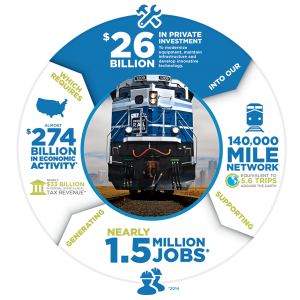Alexandria, VA — Infrastructure is front and center in post-election policy discussions as lawmakers consider President-elect Donald Trump’s $1 trillion proposal to upgrade the nation’s roads, bridges, tunnels and airports. Meanwhile, freight railroads continue to spend and invest billions of dollars of their own money in the nation’s rail network, providing a stark comparison with underfunded public infrastructure and a vivid example of how a “user pays” approach can build a world-class transportation system that benefits the public and boosts the economy.
Here are four key rail takeaways from this election season—from the big picture policy agenda to pending rulemakings at the Surface Transportation Board to rail’s place in the infrastructure plan.
 1. AAR outlines macroeconomic policy goals. Long before the dust settled on November 8, the Association of American Railroads (AAR) laid out freight rail’s long-term policy agenda, honing in on five policy areas “to ensure a vital and vibrant freight railroad industry.”
1. AAR outlines macroeconomic policy goals. Long before the dust settled on November 8, the Association of American Railroads (AAR) laid out freight rail’s long-term policy agenda, honing in on five policy areas “to ensure a vital and vibrant freight railroad industry.”
These areas include tax reform, namely creating a “simpler and fairer” tax code and reducing the U.S.’s high corporate rate; regulatory improvement that prioritizes policies that are data-driven and supported by cost-benefit analysis; infrastructure investment for the nation’s roads and highways supported by a sustainable user-pay plan; a comprehensive federal energy plan that leverages all available energy sources from coal and crude to wind and solar; and finally, fair and open trade policies that prioritize American workers and consumers.
 2. Railroads call for STB to pause rulemaking. Following the election, AAR President and CEO Ed Hamberger called on the Surface Transportation Board (STB) to suspend all major rulemakings until the incoming administration is able to fill out the five-member Board. When Congress reauthorized the STB last year, it also expanded the Board from three to five members.
2. Railroads call for STB to pause rulemaking. Following the election, AAR President and CEO Ed Hamberger called on the Surface Transportation Board (STB) to suspend all major rulemakings until the incoming administration is able to fill out the five-member Board. When Congress reauthorized the STB last year, it also expanded the Board from three to five members.
The STB is currently considering a set of proposals that would essentially reregulate the industry, jeopardizing the ability of rail carriers to invest in their infrastructure. One of the proposals, “forced access,” would require railroads to open their lines to competitors at rates determined by the government. Carriers, shippers and labor organizations have all expressed concerns about the downstream effects of the proposed new regulations, which would add thousands of new switches, impacting efficiency and safety network-wide.
“Now is not the time for midnight regulations, let alone the enactment of the unfounded proposals currently arising from the STB that will surely fail to meet the rigorous examination promised by future leaders,” said Mr. Hamberger, speaking at the RailTrends conference in New York.
 3. Infrastructure plan should follow freight rail example. While infrastructure investment is an important step to continued economic growth that members of both political parties can agree on, the source of funding for such a plan is important. Railroads foot the bill for the 140,000-mile rail network with little help from taxpayers, having spent $26 billion annually over the last five years to build, maintain and expand their lines.
3. Infrastructure plan should follow freight rail example. While infrastructure investment is an important step to continued economic growth that members of both political parties can agree on, the source of funding for such a plan is important. Railroads foot the bill for the 140,000-mile rail network with little help from taxpayers, having spent $26 billion annually over the last five years to build, maintain and expand their lines.
Following this example, the new administration should embrace a sustainable funding source for the Highway Trust Fund where highway users pay for highway infrastructure. Smart investments can bring massive economic impacts, but we have gotten away from the fundamental principle of ‘user pay.’ Solutions like a weight-distance fee would return to that principle and ensure that our roads and bridges can rely on a funding source that would continue to pay dividends in the future.
 4. Shakeup for House T&I and Senate Commerce committees. Although new congressional committee assignments won’t be announced officially until January, we know that eight members of the House Transportation and Infrastructure Committee and one member of the Senate Commerce Committee will not be returning in 2017. The Railroads, Pipelines, and Hazardous Materials subcommittee will say goodbye to Reps. Brown (D-FL), Hahn (D-CA), Hardy (R-NV), Hanna (R-NY) and Mica (R-FL). Senate Commerce, and specifically the subcommittee on surface transportation, will lose Senator Kelly Ayotte (R-NH).
4. Shakeup for House T&I and Senate Commerce committees. Although new congressional committee assignments won’t be announced officially until January, we know that eight members of the House Transportation and Infrastructure Committee and one member of the Senate Commerce Committee will not be returning in 2017. The Railroads, Pipelines, and Hazardous Materials subcommittee will say goodbye to Reps. Brown (D-FL), Hahn (D-CA), Hardy (R-NV), Hanna (R-NY) and Mica (R-FL). Senate Commerce, and specifically the subcommittee on surface transportation, will lose Senator Kelly Ayotte (R-NH).
Once committee assignments become known, GoRail will reach out to our supporters in the rail supply industry and in communities nationwide to help educate new committee members about the public and economic benefits of freight rail.

